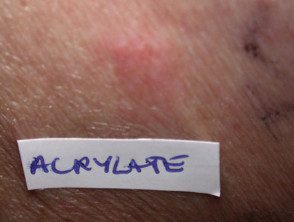What is an acrylate?
Acrylate is a chemical molecule or monomer that joins together in a process called polymerization to form plastic materials.
Acrylates in their monomeric states are very strong. irritants and Allergens. Monomers generally come in the form of powders and liquids and when combined in the polymerization process they form a flexible mixture that can be formed into any shape and then hardened. The polymerized states of acrylates are relatively inert (non-reactive). Polymerized acrylates are generally notirritating and notallergenic. It is mainly the liquid, dust or paste that should be avoided.
Acrylates were named Contact Allergens of the year 2012 by the American contact Dermatitis Society. According to the selectors, “we chose them because acrylates are everywhere in the environment.”
Where is acrylate found?
Described here are just a few of the acrylates and their wide range of applications.
methyl methacrylate
Acrylic bone cements are used in orthopedic surgery; acrylic fibers, films and inks; solvent-based adhesives and binders; doctor spray dental technology adhesives 2-hydroxyethylmethacrylate (HEMA)UV lacquer adhesive inks; dental materials; artificial nail; adhesive for false eyelashes and eyebrows; scratch-resistant glass coating; paint resins; and binders for textiles and paper.
ethyl acrylate
Acrylic resin is used in paint formulations, industrial coatings and latex; acrylic rubber and plastics; denture materials; floor polishers, sealants; shoe polishes; adhesives and in textiles and paper coatings.
Ethylene glycol dimethacrylate
Ethylene glycol dimethacrylate is used to make plastic soft drink bottles; dental materials; artificial nails; printing inks; automobile antifreeze and engine cooling fluids.
How to acrylic allergy Present?
In individuals allergic to one or more specific acrylates, direct contact with acrylate monomers produces classic allergic contact dermatitis.
- Dermatitis is usually limited to the contact area and may cause itching, burning, climbing, hives and blisters.
- Typically, fingers and hands are the areas most affected by handling acrylate monomer.
- In some cases, eczema It can occur outside the contact site as a result of monomer residue being transported by the hands to other parts of the body, such as the face (for example, acrylic nails can cause dermatitis on the eyelids, face or neck).
The powdered polymer particles may also contain the monomer. Particles can become airborne and cause symptoms such as dermatitis at exposed sites, facial swelling, rhinoconjunctivitis (hay fever) and asthma.
Who is at risk of acrylate allergy?
Anyone can develop an allergy to acrylates, but the following people are at highest risk:
- Dentist/dental technicians
- Printers
- fiberglass workers
-
Beauticians, especially those specialized in sculpted nails.
- Women manicure/sculpting artificial nails.
Am I allergic to acrylate?
Acrylate allergy is diagnosed by special allergy tests, called patch testing Methyl methacrylate and ethyl acrylate are now part of the North American standard series in the base patch test allergen series and have identified many cases of acrylate allergy. The patch test concentration for methyl methacrylate is 2% in petroleum jelly and for ethyl acrylate 0.1% in petroleum jelly.
It is believed that patch testing with methyl methacrylate, 2-hydroxymethyl methacrylate, ethyl acrylate, ethylene dimethacrylate, triethylene glycol diacrylate, and ethyl cyanoacrylate will identify most acrylates. allergies.
Acrylate monomers should not be deliberately applied to the skin “as is” for patch testing, as this risks sensitizing the individual and causing a new allergy.
Acrylate allergy patch test

Acrylate allergy patch test
What is the treatment of acrylate allergy?
Confirmation of acrylate allergy requires removal of the causative agent and management as for any acute dermatitis/eczema; This may include treatment with current corticosteroids and emollient.
What should I do to avoid an acrylate allergy?
Patients with an allergy to acrylate, and in fact all those who handle acrylate monomers, should avoid direct skin contact with them. Exposure can be minimized by wearing gloves and other protective equipment. Methyl methacrylate will pass through latex and vinyl gloves within minutes, so double gloving is recommended. Nitrile gloves are more protective.
Alert your doctor, pharmacist, dentist, veterinarian, and beautician to the fact that you are allergic to acrylate.
your dermatologist You may have more specific advice, especially if you are very sensitive to an acrylate.
Alternative names for acrylate
Some of the names of acrylates are:
- methyl methacrylate
- ethyl acrylate
- 2-hydroxyethylmethacrylate (HEMA)
- Triethylene glycol dimethacrylate
- Ethylene glycol dimethacrylate
- Bisphenol A Glycerolate Dimethacrylate (BIS-GMA)
- ethylene dimethacrylate
- Triethylene glycol diacrylate
- Ethyl cyanoacrylate.
